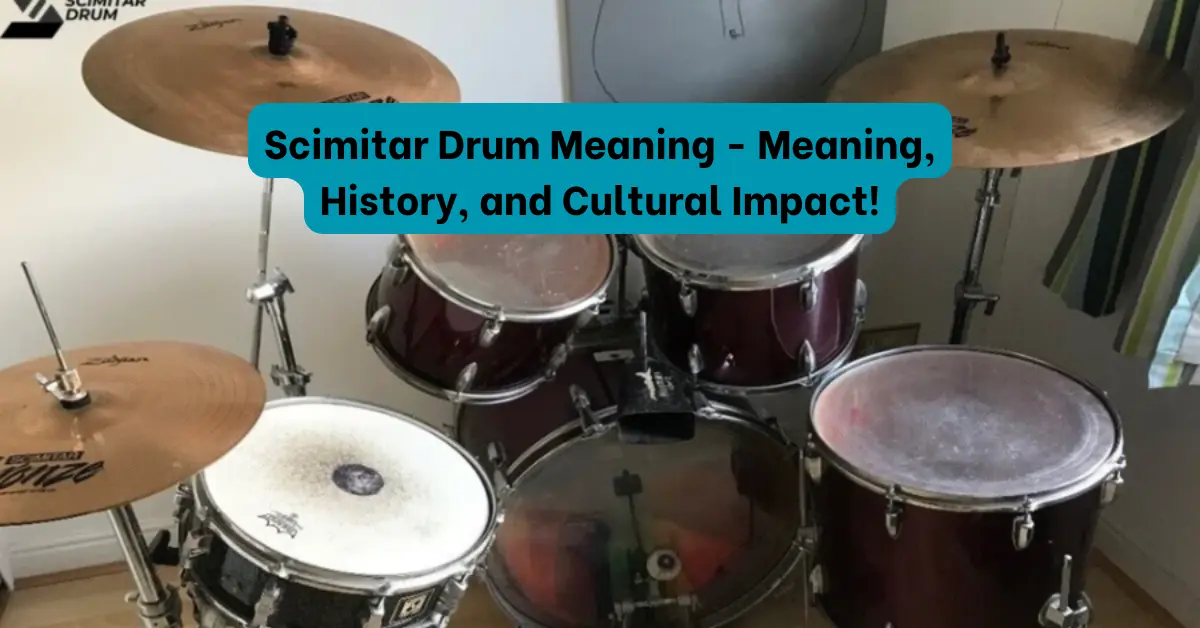Scimitar Drum Meaning – Meaning, History, and Cultural Impact!
The Scimitar Drum is a significant musical instrument with a crescent shape, symbolizing strength and protection. It connects communities through rhythm and music, playing a vital role in cultural and spiritual traditions.
Table of Contents
What is the Scimitar Drum Meaning?
The Scimitar Drum is a unique musical instrument that has a lot of significance in many cultures. Its shape is similar to a scimitar, which is a type of curved sword. This shape represents strength and protection. More than just a musical instrument, the Scimitar Drum carries deep meanings that connect communities through rhythm, music, and shared traditions.
Key Features of the Scimitar Drum Meaning:
The Scimitar Drum has special features that contribute to its meaning:
- Shape and Design: The crescent shape helps the drum produce a bright and loud sound. This unique design allows it to be heard clearly in celebrations and gatherings.
- Materials: It is usually made from natural materials like wood and animal skin. This connection to nature adds to the drum’s beauty and significance.
- Sound Quality: The sound of the Scimitar Drum is sharp and resonant, capturing the listener’s attention and creating an emotional response.
Also Read: Wedtwuk – A Cultural Celebration!
Historical Background of the Scimitar Drum:
The history of the Scimitar Drum goes back to ancient times. In many early civilizations, it was an important part of ceremonies and festivals. People used the drum to tell stories, celebrate special occasions, and bring communities together. Its presence in these events reflects the cultural values and beliefs of the people who played it.
Evolution Through the Ages
Throughout history, the Scimitar Drum has changed in how it is made and used. Originally, it was primarily a ceremonial instrument, but over time it has adapted to fit into modern music styles. This evolution shows how the drum has remained relevant while keeping its traditional roots.
Ancient Civilizations and the Origins of the Scimitar Drum
The origins of the Scimitar Drum can be traced back to ancient cultures, especially in regions like the Middle East and North Africa. In these societies, the drum was used during various events, such as weddings and harvest festivals. It helped people communicate messages, celebrate life, and connect with their ancestors.
Cultural Significance of the Scimitar Drum:
The Scimitar Drum is significant in many cultures, symbolizing unity and community. When people play the drum together, it fosters a sense of connection and shared experiences. This communal aspect of drumming strengthens social bonds and reinforces cultural identity.
Symbolism and Spiritual Meaning
The Scimitar Drum represents various spiritual ideas, including:
- Connection to the Divine: The drum is often seen as a way to communicate with higher powers, especially during spiritual ceremonies.
- Representation of Life Cycles: The rhythms created by the drum mirror the cycles of life, celebrating important moments such as births, marriages, and even funerals.
- Healing and Therapeutic Uses: The vibrations produced by the drum can have a calming effect, promoting healing and emotional release. Many believe that drumming can help reduce stress and bring peace.
Use in Religious and Cultural Ceremonies
The Scimitar Drum plays a crucial role in many religious and cultural ceremonies. It is often played to invoke spiritual energy, celebrate milestones, and mark important events. Its sound adds depth and meaning to these rituals, enriching the overall experience for participants.
Role in Rituals and Ceremonies
In various rituals, the Scimitar Drum serves several purposes:
- Setting the Mood: The drum’s sound can create different emotional atmospheres, guiding participants through the ceremony.
- Creating Unity: The act of drumming together helps participants feel connected, creating a sense of belonging.
- Marking Transitions: The drum is used to signify important transitions in life, such as coming-of-age ceremonies and seasonal celebrations.
Influence on Music and Dance
The Scimitar Drum has greatly influenced many music genres and dance forms. Its distinctive sound adds a unique rhythm that enhances performances. Musicians and dancers appreciate the drum for its ability to create excitement and energy in their art.
Figuring out Drums and Cymbals:
To understand the Scimitar Drum better, it’s essential to learn about its relationship with cymbals:
Scimitar Drum Cymbals
Cymbals are often used alongside the Scimitar Drum. They add layers of sound, creating a richer musical experience. When played together, the drum and cymbals create a harmonious blend that captures the audience’s attention.
The Significance of the Scimitar Drum
The Scimitar Drum represents cultural identity and heritage. It embodies the spirit of the communities that create and use it, serving as a reminder of their traditions, values, and shared history.
Scimitar Drum Meaning in Different Cultures
Different cultures interpret the Scimitar Drum in unique ways. From African tribal ceremonies to Middle Eastern celebrations, its significance is deeply woven into the fabric of various cultural expressions. Each culture adds its flavors and meanings to the use of the drum.
The Scimitar Drum in Modern Music
In today’s music scene, the Scimitar Drum has found its place in various genres. It appears in world music, fusion, and even electronic music. Musicians use the drum’s unique sound to create innovative rhythms, bridging the gap between traditional and modern musical styles.
How to Achieve the Scimitar Drum Sound?
If you want to create the distinctive sound of the Scimitar Drum, consider these tips:
Choose Sharp-Sounding Cymbals
Select cymbals that produce a bright and clear tone. This will complement the sound of the drum and create a fuller musical experience.
Focus on Precision
Practice your drumming techniques to ensure precise strikes. This will enhance the drum’s resonance and make the music more enjoyable.
Spiritual Symbolism of Scimitar Drum:
The spiritual meanings of the Scimitar Drum include various themes that resonate with many people:
Connection to the Divine
The drum is often viewed as a tool for spiritual connection, helping people communicate with higher powers during ceremonies.
Representation of Life Cycles
The rhythms of the drum reflect life’s cycles, celebrating both beginnings and endings, such as births, marriages, and funerals.
Healing and Therapeutic Uses
The vibrations of the drum can help promote healing, offering therapeutic benefits for emotional and mental well-being.
Also Read: Influencersgonewild’ – The New Era of Social Media!
Purchasing a Scimitar Drum:
If you are interested in getting a Scimitar Drum, here are some factors to keep in mind:
Factors to Consider
- Quality of Materials: Look for drums made from high-quality wood and animal skin to ensure the best sound.
- Size and Shape: Choose a size and shape that fits your playing style and musical needs.
Where to Buy?
You can find Scimitar Drums at music stores, online retailers, or through local craftsmen. Make sure to research reputable sellers to ensure you get a quality instrument.
Construction and Design:
Understanding the construction and design of the drum is important for making a good purchase. Look for drums with a well-made body and strong drumhead for better durability.
Materials Used
Different materials can affect the sound. Common materials include hardwood for the shell and goat or cow skin for the drumhead.
Variations in Design
Scimitar Drums come in different designs, each offering unique sound qualities. Explore various styles to find one that resonates with you and fits your musical style.
The Scimitar Drum in Contemporary Culture:
In modern times, the Scimitar Drum has seen a revival, celebrating traditional practices while blending in with modern influences.
Revival of Traditions
As more people look to reconnect with their cultural roots, the Scimitar Drum has gained popularity in community gatherings, cultural festivals, and educational workshops.
Influence on Modern Music
Its unique sound continues to inspire artists, contributing to the evolution of modern music genres and enriching creative expressions.
Role in Cultural Exchange
The Scimitar Drum helps facilitate cultural exchange, allowing musicians from different backgrounds to collaborate and create innovative sounds together.
Personal Interpretations and Insights:
The Scimitar Drum has personal meanings for many individuals. It can symbolize resilience, strength, and the transformative power of rhythm. The drum represents a universal language that connects people from all walks of life through the shared experience of music.
The Scimitar Drum as a Symbol of Resilience
Throughout its history, the Scimitar Drum has symbolized resilience. It has adapted to changes and challenges while maintaining its cultural heritage and significance.
The Transformative Power of Rhythm
Rhythm has the power to change emotions and bring people together. The act of playing the drum creates a shared experience that fosters connection and belonging.
The Universal Language of Drumming
Drumming serves as a universal language that speaks to everyone, transcending cultural differences and connecting people through shared experiences of joy and celebration.
Also Read: Hannahoetzel2 – A New Era in Digital Engagement!
Learning to Play the Scimitar Drum – Where to Start?
If you’re interested in learning how to play the Scimitar Drum, there are plenty of resources available to help you get started:
Online Resources
Many websites offer tutorials, videos, and courses for beginners and experienced drummers alike. These online resources can help you learn the basics of drumming, improve your skills, and discover different playing styles.
In-Person Lessons
Taking in-person lessons from skilled drummers can be very beneficial. This hands-on approach allows for personalized feedback and guidance, helping you to improve your technique and understand the nuances of playing the Scimitar Drum.
FAQs:
1. What is the significance of the Scimitar Drum in different cultures?
The Scimitar Drum symbolizes unity and community, with unique meanings across cultures, enhancing ceremonies, celebrations, and rituals, fostering connections through music.
2. How is the Scimitar Drum constructed?
The Scimitar Drum is typically made from high-quality wood and animal skin, featuring a crescent shape that produces bright sounds, making it suitable for various musical styles.
3. What role does the Scimitar Drum play in spiritual ceremonies?
The Scimitar Drum serves as a tool for spiritual connection, helping participants communicate with higher powers and celebrating important life cycles during ceremonies.
4. How has the Scimitar Drum evolved over time?
Initially a ceremonial instrument, the Scimitar Drum has adapted to modern music styles while retaining its traditional roots, continuing to inspire musicians today.
5. What resources are available for learning to play the Scimitar Drum?
Beginners can find online tutorials, videos, and in-person lessons to learn about drumming techniques, styles, and the nuances of playing the Scimitar Drum.
Conclusion:
The Scimitar Drum is more than just a musical instrument; it embodies cultural heritage, spiritual significance, and communal identity. Its unique crescent shape and vibrant sound play essential roles in celebrations and rituals across various cultures. As it adapts to modern music, the drum continues to inspire new generations, fostering connections between people through shared experiences of rhythm and celebration. Embracing its rich history enhances our appreciation for this powerful symbol of unity and creativity.







